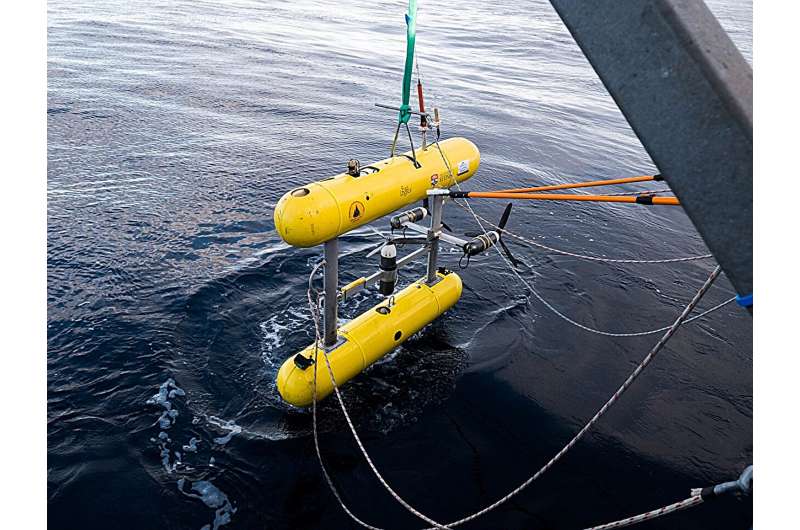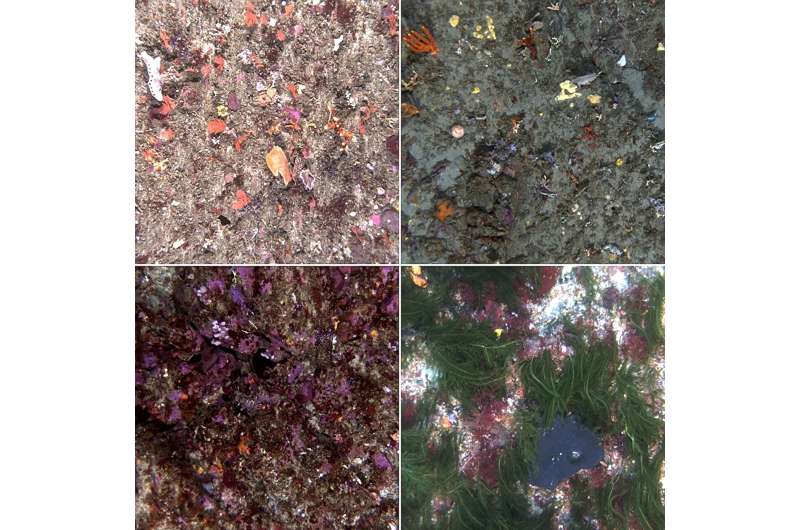This article has been reviewed according to Science X's editorial process and policies. Editors have highlighted the following attributes while ensuring the content's credibility:
fact-checked
peer-reviewed publication
trusted source
proofread
Going deeper for healthy offshore reefs in Storm Bay

Scientists have used high-tech underwater robots to take a closer look at the deep offshore reefs on the east coast of Bruny Island in Tasmania and have revealed the seabed biodiversity there for the first time.
In a new study, researchers at the University of Tasmania's Institute for Marine and Antarctic Studies (IMAS) collected more than 61,000 images of three reef systems in Storm Bay at depths of 30–60 meters. This was achieved using an advanced Autonomous Underwater Vehicle operated in partnership with the University of Sydney's Australian Center for Field Robotics, as part of Australia's Integrated Marine Observing System (IMOS).
"The imagery we captured has given us an initial understanding of the seabed biodiversity across these deep offshore reefs, and an inventory that provides an important baseline for tracking how that biodiversity changes over time," said IMAS marine ecologist Ashlee Bastiaansen, who is the lead author of the study published in Ecological Indicators.
"In addition to noting that seaweed cover dominates the shallower depths of these reefs, and sponges, corals, and other seabed animals are more prevalent below 40 meters, we observed a general decline in the overall diversity of organisms on these deep reefs between 2015 and 2020.
"We also found that the green macroalgae Caulerpa, which is a feature of reef tops at depths of 30 meters in this area, had become shallower and reduced in cover over this period.
"This is important because changes in the distribution and abundance of key species like Caulerpa can indicate shifts in ecosystem health and function, potentially affecting the broader reef community and its resilience to environmental changes," said Bastiaansen.
IMAS Project Lead and co-author, Associate Professor Neville Barrett said these deep reefs were relatively inaccessible, so were not well studied. "Yet they host high levels of biodiversity and important commercial and recreational fishery values," he said.
"With the increasing human pressures on coastal regions, including nutrient inputs from cities and recent offshore aquaculture developments, baseline studies like this are vital for monitoring and managing the health of deep reef ecosystems."

The images and annotations from the work are hosted on the IMOS SQUIDLE+ online platform which offers a permanent, publicly accessible baseline for monitoring the remarkable ecosystems in Storm Bay.
"This baseline data provides an essential foundation for evidence-based management plans for Storm Bay," Bastiaansen said.
"While the work described in this paper is based on two time points, the true value of these publicly accessible images and baseline annotations will become apparent over time."
SQUIDLE+ is an open software platform for the management, discovery and annotation of marine imagery developed as part of Australia's Integrated Marine Observing System's Understanding of Marine Imagery Facility. IMOS is enabled by the National Collaborative Research Infrastructure Strategy (NCRIS).
More information: Ashlee Bastiaansen et al, Taking a deeper look at the biodiversity on temperate mesophotic reefs to inform adaptive management of impacts in Storm Bay, Tasmania, Ecological Indicators (2024). DOI: 10.1016/j.ecolind.2024.112345
Journal information: Ecological Indicators
Provided by University of Tasmania





















